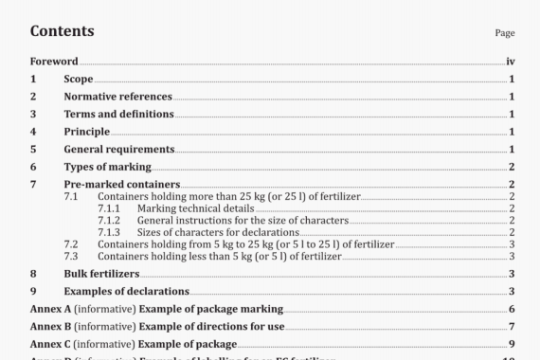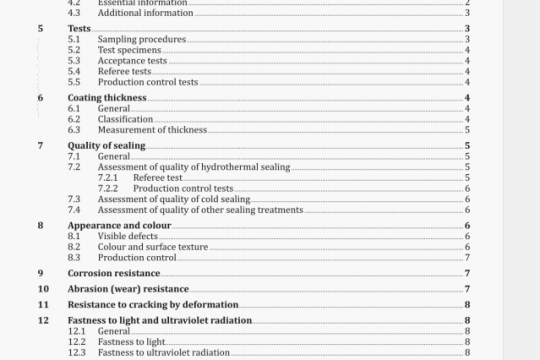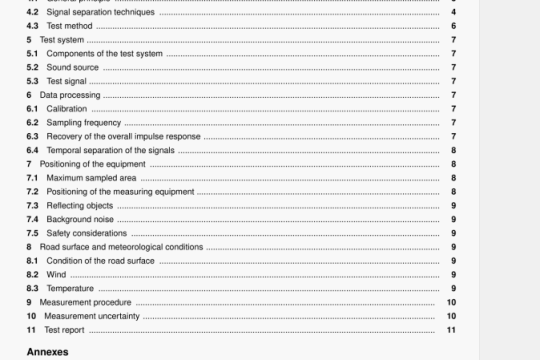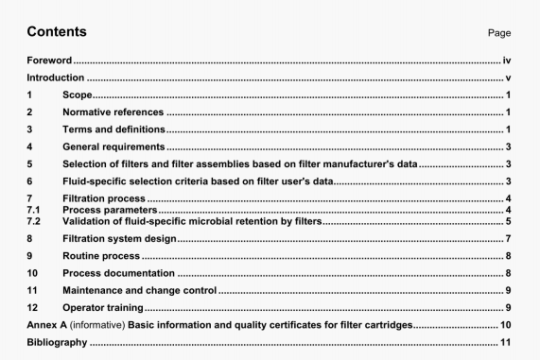AS ISO 9705:2003 pdf download
AS ISO 9705:2003 pdf download.Fire tests—Full-scale room test for surface products.
6.1.3 The burner shall be supplied with natural grade propane (95 % purity). The gas flow to the burner shall be measured with an accuracy of at least ± 3 %. The heat output to the burner shall be controlled within ± 5 % of the prescribed value.
6.2 Alternative sources
Alternative sources as specified in annex B may also
be used.
7 Heat flux instrumentation in the fire room
This clause specifies minimum requirements for heat flux instrumentation in the fire room. Additional information and designs can be found in annex C.
7.1 Specification
The heat flux meter shall be of the Gardon (foil) or the Schmidt-Boelter (thermopile) type with a design range of about 50 kW m2. The target area shall be a flat black surface having a view angle of 1800. The heat flux meter shall have an accuracy of at least ± 3 % and a repeatability within 0,5 %. In operation, the meter shall be maintained at a constant temperature (within ± 5 °C) above the dew point.
7.2 Location
The heat flux meter shall be mounted at the geometric centre of the floor. The target area shall be 5 mm to 30 mm above the floor surface. Radiation shall not pass through any window before reaching the target.
7.3 Calibration
The calibration of the heat flux meter shall be checked whenever required, by comparison with two instruments held as reference standards and not used for any other purpose. One of the reference standards shall be fully calibrated at yearly intervals.
NOTE 4 An example procedure is given in BS 6809.
8 Hood and exhaust duct
The system for collecting the combustion products shall have a capacity and be designed in such a way that all of the combustion products leaving the fire room through the doorway during a test are collected. The system shall not disturb the fire-induced flow in the doorway. The exhaust capacity shall be at least 3,5 m3 1 at normal pressure and a temperature of 25 C.
NOTE 5 An example of one design of hood and an exhaust duct is given in annex D.
9 Instrumentation in the exhaust duct
This clause specifies minimum requirements for instrumentation in the exhaust duct. Additional information and designs can be found in annex E.
9.1 Volume flow rate
The volume flow rate in the exhaust duct shall be measured to an accuracy of at least ± 5 %.
The response time to a stepwise change of the duct flow rate shall be a maximum of 1 s at 90 % of the final value.
9.2 Gas analysis
9.2.1 Sampling line
The gas samples shall be taken in the exhaust duct at a position where the combustion products are uniformly mixed. The sampling line shall be made from an inert material which will not influence the concentration of the gas species to be analysed. (See annex Ej
9.2.2 Oxygen
The oxygen consumption shall be measured with an accuracy of at least ± 0,05 % (V/V) oxygen. The oxygen analyser shall have a time constant not exceeding 3 s. (See annex E.)
9.2.3 Carbon monoxide and carbon dioxide
The gas species shall be measured using analysers having an accuracy of at least ± 0,1 % (V/V) for carbon dioxide and ± 0,02 % (V/V) for carbon monoxide. The analysers shall have a time constant not exceeding 3 s. (See annex E.)
9.3 Optical density
9.3.1 General
The optical density of the smoke is determined by measuring the light obscuration with a system consisting of a lamp, lenses, an aperture and a photocell, (see figure 2). The system shall be constructed in such a way as to ensure that soot deposits during the test do not reduce the light transmission by more than 5 %.
10 System performance10.1 Calibration
A calibration test shall be performed prior to each testor continuous test series.
NOTE 6 Equations for calculations are given in annex F.The calibration shall be performed with the burnerheat outputs given in table 1, with the burner pos-itioned directly under the hood. Measurements shallbe taken at least every 6 s and shall be started 1 minprior to ignition of the burner. At steady state con-ditions, the difference between the mean rate of heatrelease over 1 min calculated from the measuredoxygen consumption and that calculated from themetered gas input shall not exceed 5 % for each levelof heat output.




